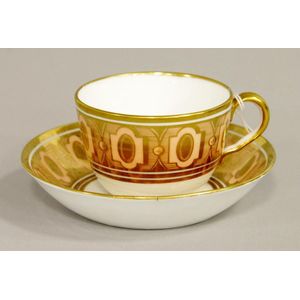Pink Worcester Cup & Saucer with Classical Figures
A Worcester Barr Flight & Barr cup and saucer, circa 1810 transfer decorated with classical figure scenes on a pink ground within gilded borders, impressed crowned BFB mark the cup 7 cm high, the saucer 14 cm diameter
You must be a subscriber, and be logged in to view price and dealer details.
Subscribe Now to view actual auction price for this item
When you subscribe, you have the option of setting the currency in which to display prices to $Au, $US, $NZ or Stg.
This item has been sold, and the description, image and price are for reference purposes only.
- Circa - A Latin term meaning 'about', often used in the antique trade to give an approximate date for the piece, usually considered to be five years on either side of the circa year. Thus, circa 1900 means the piece was made about 1900, probably between 1895 and 1905. The expression is sometimes abbreviated to c.1900.
- Gilding - Gilding is a method of ornamentation whereby a thin sheet of gold metal is applied to items made of wood, leather, ceramics, glass and silver for decorative purposes.
For furniture including mirrors, the sheet of gold is usually applied over a coating of gesso. Gesso is a mixture of plaster of Paris and gypsum mixed with water and then applied to the carved wooden frames of mirrors and picture frames as a base for applying the gold leaf. After numerous coats of gesso have been applied, allowed to dry and then sanded a coat of "bole", a usually red coloured mixture of clay and glue is brushed on and allowed to dry, after which the gold leaf is applied. Over time parts of the gilding will rub off so the base colour can be seen. In water gilding, this was generally a blue colour, while in oil gilding, the under layer was often yellow. In Victorian times, gilders frequently used red as a pigment beneath the gold leaf.
Metal was often gilded by a process known as fire gilding. Gold mixed with mercury was applied and heated, causing the mercury to evaporate, the long-term effect of which was to kill or disable the craftsman or woman from mercury poisoning. The pursuit of beauty has claimed many victims, not the least of which were the artists who made those pieces so highly sought after today. - Transfer Printed / Decorated Transferware - Transfer printing is method of decorating ceramics, reducing the cost of decoration when compared to employing artists to paint each piece. A print was taken on transfer-paper from an engraved copperplate, covered in ink prepared with metallic oxides, and the image on the paper was then applied to the biscuit-fired ceramic body. The print was fixed by heating the object in an oven, and then glazed, sealing the picture. Early transfer prints were blue and white, as cobalt was the only colour to stand firing without blurring. Early in the 19th century advances in the composition of the transfer paper resulted in better definition and detail, and enabled engravers to combine line-engraving with stipple.
This item has been included into following indexes:
Visually similar items

A Chelsea Derby putti and amorous trophies cup and saucer attributed to Richard Askew circa 1775, gilt conjoined anchor and D mark
Sold by
in
for
You can display prices in $Au, $US, $NZ or Stg.

A 19th century Copeland & Garrett teacup and saucer with geometric gilded decoration.
Sold by
in
for
You can display prices in $Au, $US, $NZ or Stg.

An 18th century Derby porcelain tea cup and saucer with blue and gilded decoration. Crowned Derby mark.
Sold by
in
for
You can display prices in $Au, $US, $NZ or Stg.

A John rose Coalport coffee can and saucer, circa 1810 12 cm,
Sold by
in
for
You can display prices in $Au, $US, $NZ or Stg.
